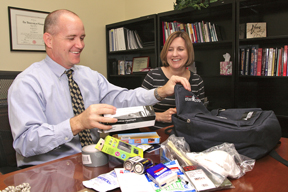Researchers with the UAB Social Work Program and Children’s Hospital are conducting a study to determine the level of at-home disaster preparedness among families who have children with special health-care needs.
 |
| Mark and Lisa Baker are conducting a study to determine the level of at-home disaster preparedness among families who have children with special health-care needs. |
The study focuses on families who have children on daily medication, use electrical devices as part of at-home care and rely on devices to aid in mobility such as wheelchairs. These subjects are being compared to normal controls to assess the levels of preparedness.
Lisa Baker, Ph.D., assistant professor of social work, and Mark Baker, M.D., department of pediatrics/emergency medicine, are co-principal investigators for the study. They say previous studies show many parents are not prepared to provide for their family’s basic needs in the event of a natural or man-made disaster.
“Current research tells us that less than one-third of families are prepared in the case of a disaster, and we know children with special health-care needs pose a special concern for families,” Lisa Baker says.
“We wanted to conduct this study to look at the families of children with special medical needs to see if they are any more prepared.”
Preliminary results
Study participants have been selected at random from patients at Children’s Hospital. Baker says they want to know if families have a written communication plan, a personal disaster kit and a medical plan for their child.
Half of the families surveyed are given information giving them detailed steps on how to become prepared. The other families are given a personal disaster kit donated by the Jefferson County Emergency Management Agency and the Jefferson County Citizens Corps, along with the education materials showing how to continue developing a full disaster plan. The study will have enrolled 400 families at its completion. Almost 100 families have been surveyed, and Baker says the preliminary results mirror previous studies from around the country.
“What we’re finding is not much different from what the research has told us,” she says. “About 11 percent of families have a written communication plan in place. About 18 percent of the families have a personal disaster kit.”
What is a disaster?
A disaster is any exposure to a hazard that threatens personal safety, disrupts family and community functioning and results in personal and societal loss. Disasters include tornados, flooding, severe weather, earthquakes and wildfires, as well as terrorist attacks, bombings and chemical or biological exposures and spills.
Mark Baker says previous disasters have shown a disruption in services can cause great strain on families of children with special health-care needs, and on pharmacies and emergency rooms.
“Some of the things we’ve seen after previous disasters is that families with children that require special health care run out of medication or they need to access emergency departments more frequently to obtain medication refills or treat medical problems that arise,” he says. “These families may be the most vulnerable in the sense that they are more likely to utilize special-needs shelters or emergency departments during a disaster.”
Baker says now is the best time for families in the South to formulate a disaster plan for their families.
“All families should take a few minutes to get prepared before our severe weather season really gets in gear,” he says. “Taking planning steps now can go a long way to preventing problems during a crisis.”
Educational intervention
Part of the study includes an educational intervention to see if the level of at-home preparedness improves. Lisa Baker says families will be contacted a few months after they filled out the initial survey.
“For the families that received a kit we want to know if they needed to access anything in it and for what purpose,” she says. “We also want to know if the kit is still intact in the home. We also want to know if those who did not receive a kit have taken steps to make their families better prepared.
“These results really are to inform how we can better prepare families and find out what is going to be the intervention that actually encourages the families to get prepared. We know there’s been some large-scale media information out there encouraging families to be prepared, but many are still struggling with that.”
For information on UAB’s policies and procedures during any emergency or severe weather situation, please visit the UAB Emergency Information Web page at www.uab.edu/emergency. The page also contains links to internal and external emergency support and information resources.
What should be in your disaster supplies kit?
Assemble and store supplies you need in an easy-to-carry container like a backpack or duffle bag.
Items to include are:
• A supply of water in sealed, unbreakable containers.
• A supply of non-perishable packaged or canned food and a non-electric can opener.
• A change of clothing, rain gear and sturdy shoes.
• Extra supply of diapers and powdered formula for families with infants.
• A favorite toy, stuffed animal and coloring book for children.
• Blankets, duct tape, utility knife and toiletries.
• A first-aid kit and prescription medications, nebulizers, inhalers, etc.
• A battery-powered radio, flashlight and plenty of extra batteries.
• Credit cards and cash.
• An extra set of car keys.
• A list of family physicians.
• A list of important family information; the style and serial number of medical devices such as pacemakers.